|
New York Architecture Images- Central Park
Columbus Circle Fountain |
|
|
Sculptor |
Gaetano Russo |
|
location |
Columbus Circle |
|
date |
Unveiled 1892 |
|
style |
Beaux-Arts |
|
construction |
70-foot granite column with bronze reliefs |
|
type |
Monument |
|
|
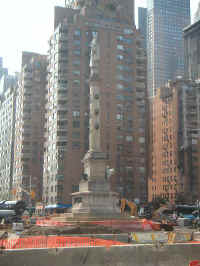 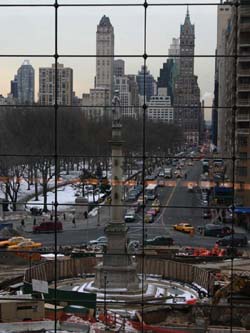 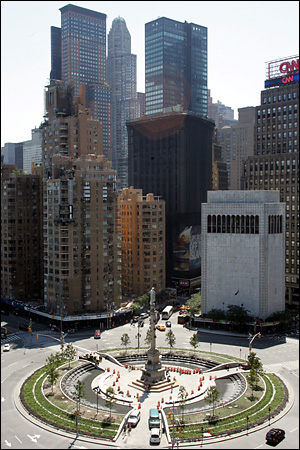 |
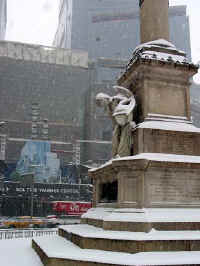 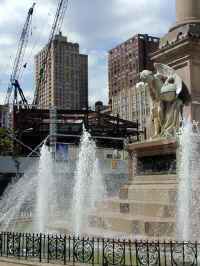 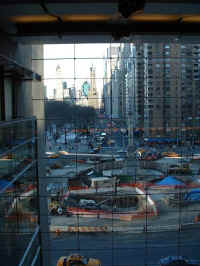 |
|
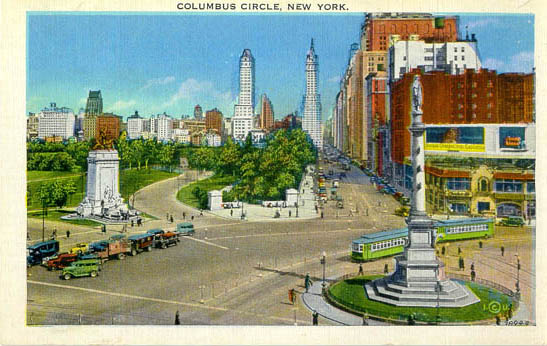 |
|
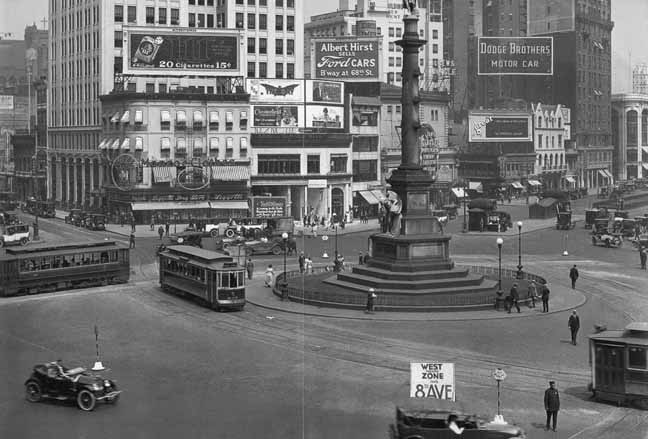 |
|
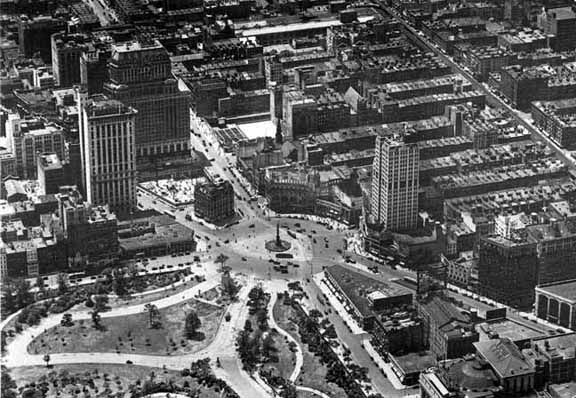 |
|
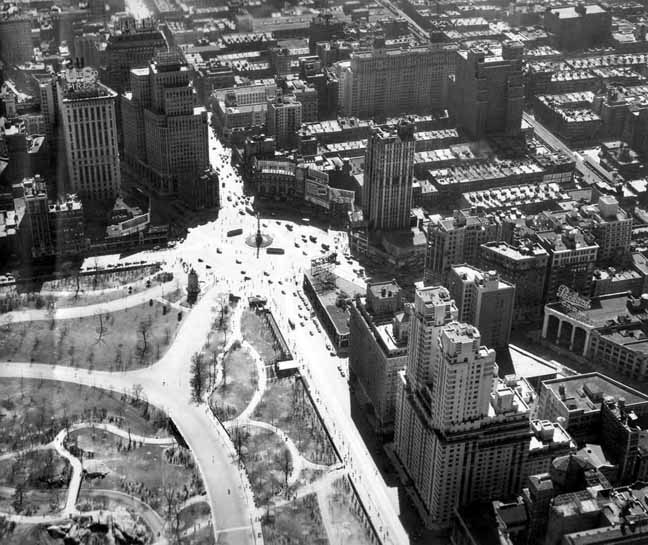 |
|
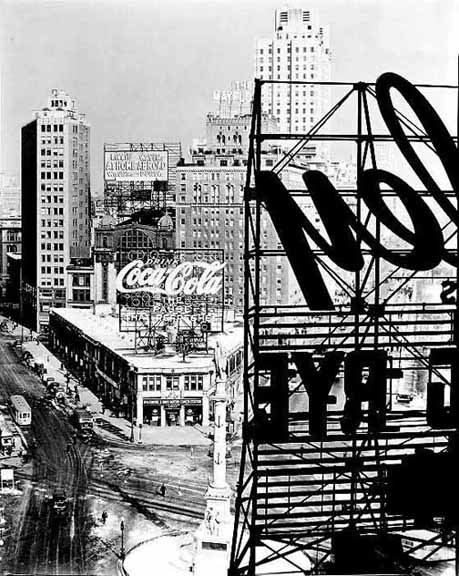 |
|
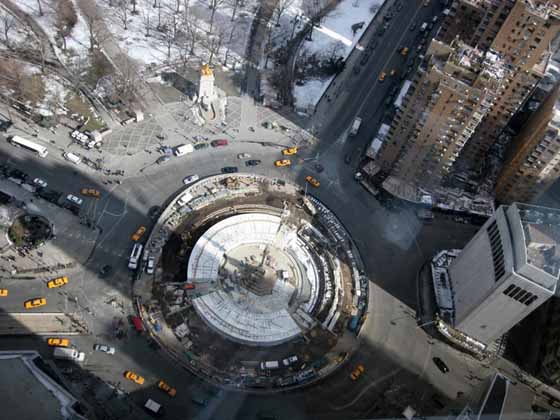 |
|
|
images |
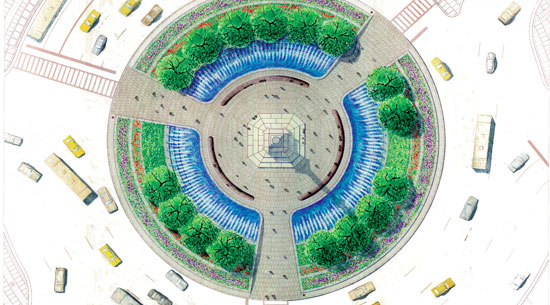 |
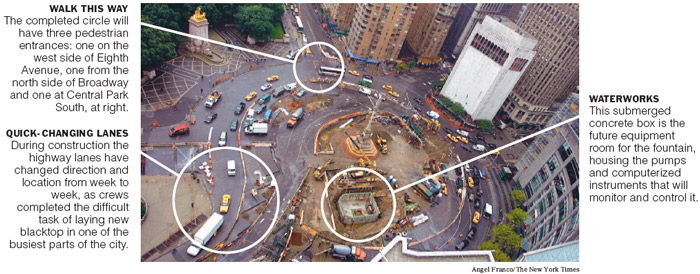 |
|
 |
|
 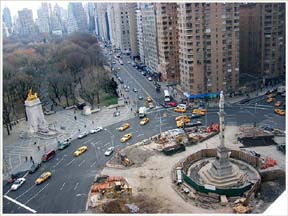 |
|
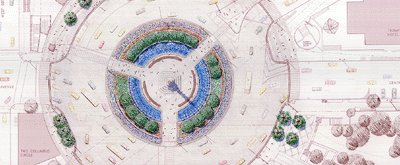 |
|
|
New York Times
August 4, 2005 An Island of Sanctuary in the Traffic Stream By DAVID W. DUNLAP 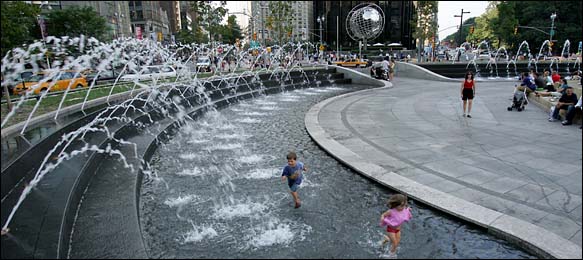 Columbus Circle, at the confluence of thoroughfares at a corner of Central Park, has a whole new look. Children evaded the heat by playing in the new fountains. 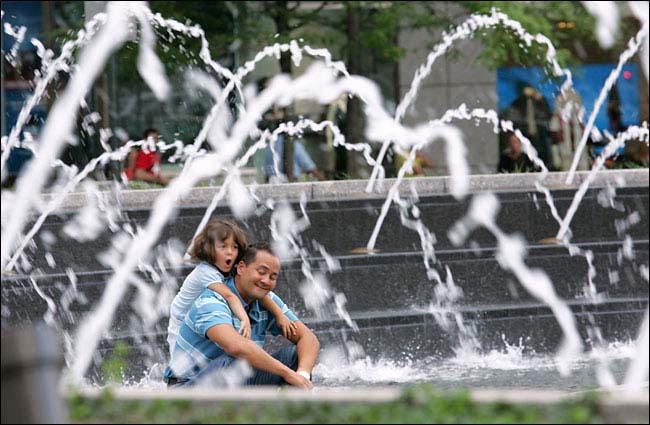 Randal Yang and his daughter, Haley, enjoyed the cooling spray. 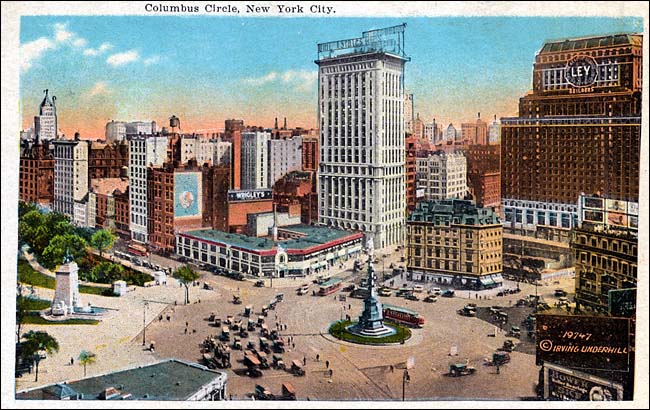 A view of Columbus Circle in a less-trafficked time around 1925, from a postcard of the era. At last, the circle has a center. Columbus Circle was once one of the least approachable of New York's great public intersections. The architecture critic Paul Goldberger described it in 1979 as "a chaotic jumble of streets that can be crossed in about 50 different ways - all of them wrong." Today, there are three different ways to cross Columbus Circle. And they are leading a growing number of pedestrians to a surprisingly generous sanctuary at the heart of a busy traffic rotary, cocooned inside a wrap-around fountain with 99 jets whose arcs suggest the circle itself and whose changing sound masks the surrounding hubbub. "Even incomplete, you see the potential for a glorious public space," said Amanda M. Burden, the director of the City Planning Department, which has worked for nearly two decades to put the fragmented circle back together. The new Columbus Circle has not yet officially opened. (Monday, Oct. 10, suggests itself as a possibility for that ceremony.) But New Yorkers have already arrived. Forgoing the air-conditioned Time Warner Center a few yards away and unfazed by the lack of benches - they are due any day from Milwaukee - people hang out on the tiered, octagonal base of the Columbus Monument as if it were a front stoop, with a view of Broadway, Central Park West, Central Park South and Eighth Avenue. "We've actually opened it up ahead of having benches," said David J. Burney, the commissioner of the city's Department of Design and Construction. "Every time I was there, there were people at the barriers to the entrances saying: 'I want to get in. I want to get through.' There are quite strong desire lines for pedestrian traffic." Around 9 o'clock on Tuesday night, three dozen people were gathered around the monument, eating, drinking, smoking, reading the paper, playing games on a cellphone, nestling affectionately, staring into space. Others sprawled languorously on the granite edges of the fountain, where a terrier chased water spouts and a little boy dipped his hand into the spray. An ill-kempt man bathed his feet furtively - but, it seemed, gratefully. "The good thing is being able to get to the center," said Ethel Sheffer of Community Board 7 on the Upper West Side, who was the chairwoman of a Columbus Circle task force that also included Boards 4 and 5. "We all wanted New Yorkers to be able to go there." In the decades after the Columbus Monument was dedicated in 1892, the Grand Circle (as it was once called) was exactly that, a broad rotary for vehicles and streetcars with a circular public space at its center not much larger than the monument's base. Things were never the same after 1929, when Police Commissioner Grover Whalen ordered an end to the circular traffic flow. By the 1960's, despite the installation of a fountain around the monument, the central area had become an unwelcoming and amorphous archipelago where motorcycles parked but pedestrians crossed at some peril. COLUMBUS CIRCLE is like a black hole," Ms. Sheffer said in 1987. "Cars go in, cars go out, but you never know what's going on inside." That year, in a report to the planning department, the architectural firm Skidmore, Owings & Merrill proposed a larger, more circular island. As finally realized under a $20 million city contract, Columbus Circle was redesigned by the Olin Partnership, working with Vollmer Associates. The fountain is by Wet Design. Tully Construction Company is the contractor. The new Columbus Circle gives New Yorkers the chance to understand a critical element of the future World Trade Center memorial: how the sound of water can muffle distracting urban noise. Almost inaudible outside the four-foot-high landscaped mound surrounding the circle, the fountain dominates the experience within. "It gives you that sense of being in the heart of the city with a sense of insulation from traffic," said Joseph B. Rose, who worked on the project when he was Mayor Rudolph W. Giuliani's planning director. Depending on the force and size of the fountain jets, which alternate, the sound can evoke a swollen river, a rushing brook, a driving rain or a gentle shower. At the trade center memorial, cascading water walls will surround each of the voids that are to mark the absence of the twin towers. The Columbus Circle fountain begins to suggest how important sound will be. "I've always tried to impress upon people that it's a sensory experience," said the architect Michael Arad, who won the memorial design competition in 2004 with Peter Walker & Partners. Anna Hayes Levin, the chairwoman of the Clinton-Hell's Kitchen land-use committee of Community Board 4, said she was discouraged by the extent of hard, unshaded space within Columbus Circle. But she praised the restoration of the circular traffic flow, the creation of clear pedestrian access and the limited disruption caused by construction. And she said, "I'm glad they finally have the fountain on, because for the last couple of months, it has been a skateboard park." Mr. Burney said that would soon end with the installation of small stainless-steel clips on the sloping surfaces around the fountain "that spoilsports like me put on skateboarding walls." So what about all those children wading in the fountain? Are they allowed to do that? "No, they're not," Mr. Burney answered. "But it was so hot last week, one could hardly blame them. I felt like jumping in there myself." Copyright 2005 The New York Times Company
|
|
|
Situated in the center of Columbus Circle, at
the southwest perimeter of Central Park is a magnificent towering marble
statue of Christopher Columbus. The Italian mariner and navigator, is
credited as the first European to sail across the Atlantic Ocean and
with the discovery of the American continent. He stands atop the
monument on a 70-foot granite column with bronze reliefs. The three
ships depicted on the column represent the Nina, the Pinta, and the Santa Maria, the ships he sailed in 1492. At its base is a fountain with an angel holding a globe. Four hundred years later, to commemorate his voyage, this statue of Columbus was unveiled and presented by Italy to the United States. Donated by Italians in U.S. through subscriptions raised by newspaper, Il Progresso the city's largest-circulation foreign-language daily newspaper. |
|
|
After more than a year of studies, the City
administration announced that the new traffic configuration at Columbus
Circle -- aimed at taming vehicular traffic and giving more space back
to pedestrians -- proved more successful than anticipated. The new
configuration follows the actual circle and allows for a center space
close to 180 feet in diameter, as well as substantially widened
surrounding sidewalks. The traffic studies concluded that this layout
works--for cars, for pedestrians and for bicyclists. The NYC Parks Department implemented an interim design for the Circle's center space that creates a welcoming oasis of seasonal plantings, seating and an improved paving surface. The Society praised the interim plan in letters to Parks Commissioner Henry Stern and City Planning Chairman Joseph Rose, but we called upon the City to add a crosswalk between the center circle and the Merchant's Gate entrance to Central Park. This would make pedestrian access between the two destinations safer and easier. After an extensive RFP process, the City selected the engineering firm Vollmar Associates and the design firm McCobb and Associates to develop a permanent new design for Columbus Circle. When their plans met opposition from community groups, civic organizations, community boards and city agencies, the City hired the Olin Partnership in the Spring of 2002 to develop a proposed scheme for the re-design of the public space at Columbus Circle. The MAS has advocated that Columbus Circle become one of the great civic spaces of the world, and that a world-class design be created for this site. In l997, the MAS invited six prominent designers to propose designs for the circle; these results were published in a special issue of The Livable City entitled "Full Circle: Invited Designs for Columbus Circle. The Olin Partnership, in conjunction with Machado Silvetti, formed a team for this consultation. A selection from their proposal is pictured left. The Department of City Planning is currently presenting the Olin Partnership design to the Tri-Board Task Force on Columbus Circle, the MAS and other interested civic groups. On September 9th, 2002, the Art Commission held the first public hearing on the Olin Partnership proposal, where the MAS delivered testimony. Once the design is approved, the City hopes to begin construction in the Spring of 2003. The design intent for Columbus Circle returns the historic monument to public access and appreciation, fostering an environment not present for a generation. The proposed design has been conceived to make the site a safe and attractive addition to the public realm of New York City at one of the principal entries to Central Park and the intersection of three significant streets: Broadway, Eight Avenue and 59th Street. The design features – paving, planting, fountains, seating and lighting – all reinforce the simple idea that Columbus Circle is unique in the City. The island consists of a series of concentric rings that buffer the traffic and provide a pleasant pedestrian environment for the monument, consisting of a broad, gently raised area of planting, a series of fountains, paving, benches and lights. On the outer perimeter, a ring of raised stone cobbles provides an emerging pedestrian refuge adjacent to the outer vehicular lane, which, in winter, can also accept piles of snow and salt without damage to planting. Next, a ring of colorful low plantings is formed, which can be changed and replenished seasonally. This is encircled by evergreen shrubs, placed to enhance the floral display, and a ring of trees standing in evergreen groundcovers, underplanted with spring bulbs. Proposed American Yellow Buckeye frame axial views to the historic monument, while providing a partial enclosure in the form of a circular room, in the center of which stands the monument. New benches, scaled to complement the civic space, are to be made of curved wood, designed to be large enough to allow individuals and groups to sit comfortably back to back, facing either the active water and planting or the monument. The small fountain currently surrounding the monument base is to be removed, allowing the column base to sit firmly on the ground as the central feature of the circle. People will once more be able to approach the monument, to read the inscriptions, and to study the relief sculptures on the base more easily than in recent decades. To replace the loss of the central fountain, new basins are to be created that encircle the central open area. More generous than the former basin and shaped as a series of concentric ledges to form cascades with arching jets towards the center, the new fountains will reinforce the circular design and primacy of the monument, while masking the noise of the traffic and tempering the climate in summer. The fountain is designed to form a series of bleacher seats which, when turned off, avoid the forlorn character of so many empty fountain bases in the City, visible during the colder months. It is the intent of these simple gestures to make obvious the importance of this civic space and monument, and to return it to the citizens and visitors of New York City as an inviting celebratory place. It is a place to pause and refresh oneself in the midst of one of the busiest intersections in the metropolis – a foyer to Central Park, an event on Broadway, and a handsome scene for those who live, work and visit this great city. http://www.olinptr.com/project_current_urban2.html Which Way Is Out? Solving the Riddle of the Circle STEVEN KURUTZ PERHAPS the best spot from which to view the construction that has overtaken Columbus Circle is not at ground level, but from the lobby of the Mandarin Oriental hotel, 35 stories above the city in the Time Warner Center, where this eastward-looking photograph was taken. From this lofty vantage, the entire site is laid out in precise, almost elegant detail: the improvised traffic lanes that shift to accommodate construction; the beginnings of what will be the wide outer ring; the steady procession of taxis, cars and heavy machinery around the Columbus monument. The $15 million renovation that will transform Columbus Circle is nearing the end of the heavy work phase. By mid-August, roadwork is expected to be completed and crews will move inside the circle to install a three-tiered fountain and to plant trees and other greenery. Matthew Monahan, a spokesman for the Department of Design and Construction, said the city plans to complete the project by year's end. For pedestrians and drivers who have withstood untold nuisances from pounding jackhammers and rumbling trucks, that prospect is welcome news. Which brings us to another reason that the view from the Mandarin is so spectacular: Up here, the only sound is the gentle whir of the air-conditioning. Copyright 2004 The New York Times Company |
|
|
links |
thanks to www.centralpark2000.com & www.centralparknyc.org |